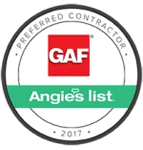
Are you considering roofing replacement? With so many factors to think about, starting a roofing replacement project can feel like a challenge for many homeowners in Fairfax, Virginia, and Maryland. It’s a huge investment but it’s necessary for improving the safety of your home, its aesthetics, and increasing its market value.
This complete guide from our team at NuHome provides you with a complete understanding of the roofing replacement process, signs that you need a roof replacement, and some practical tips. This in turn will help you navigate the process of getting a new roof for your home in Fairfax, Virginia, and Maryland.
Knowing When to Repair or Replace Your Roof
Determining the condition of your roof is the first step in deciding if a repair will work or if a complete replacement is necessary. Roof repairs might be adequate for minor issues such as a few missing shingles or minor leaks. But when the roof shows signs of aging or damage, replacement is a more cost-effective and safer option.
Signs You Need Roof Replacement
Understanding when to replace your roof is key to maintain the structure and safety of your home. Over time, exposure to harsh weather can wear down even the best roofing materials. Below are the various signs that indicate a need for roof replacement:
1. Old Age
An aging roof often shows major signs of deterioration such as curling or warping shingles, missing shingles or tiles, and shingle granules in the gutters. An aging roof may also lead to increased energy bills due to bad insulation and air leaks. This might tell you that roofing replacement is necessary.
2. Water Damage
Visible damage often requires action right away as it can increase the risk of water damage. If your roof is sagging, this is a major indication that your roof has suffered water damage and needs to be replaced. Pay attention to leaks in chimneys, vents, and skylights for damaged flashing, as this increases the likelihood of water damage.
3. Interior Damage
Sometimes, signs from inside your home can indicate roof problems. Water stains or mold on ceilings and walls are indicative of leaks, and seeing daylight through roof boards is a clear sign of serious issues.
4. Leaks
Persistent leaks are serious indicators that your roof’s integrity is compromised, and small leaks can quickly turn into large problems, potentially leading to structural damage.
5. Pests
Signs of pests such as termites or rodents can indicate that there are openings and weaknesses in your roof structure.
If you notice any of the signs mentioned above, you should consult with a professional roofer who can provide a full inspection and outline your options. They can help you determine whether repairs will suffice or if a full replacement is necessary based on the age and condition of your roof.
Factors that Influence the Cost of Roofing Replacement in Fairfax, Virginia, and Maryland
The cost of replacing a roof in Fairfax, Virginia, and Maryland varies widely and is influenced by several key factors that you need to consider before starting this major home improvement project:
- Size and Pitch
Larger and steeper roofs require more materials and more labor, which can increase the project’s cost. Steeper roofs are also more challenging and hazardous to work on and can further increase labor costs because of the specialized equipment and safety measures required.
- Material Choices
The choice of roofing material also affects the cost of your roof replacement. Asphalt shingles are among the most affordable and popular options because of their cost-effectiveness and simple installation process. On the other hand, materials like slate, metal, or tile typically come at a higher price point.
- Labor Costs
Complex roof designs with multiple valleys, dormers, or other architectural features generally require more time and expertise to replace which can increase the cost. Additionally, the contractor’s skill level, experience, and regional labor rates also play into the roofing costs.
- Insurance and Warranties
It’s important to understand what your insurance covers. Damage due to natural disasters is typically covered, whereas wear and tear might not be. Also, you should consider manufacturer warranties on materials and contractor warranties on workmanship.
The Best Time for Roof Replacement
Here’s what you should know about the best times to get roofing replacement in Fairfax, Virginia, and Maryland:
- Best Seasons
Late spring to early fall is typically the best time to replace a roof. The weather is the best during these months which is crucial for roofing installations. Dry and mild conditions guarantee that the installation goes smoothly, and the materials are set properly.
- Off-Season Advantages
There are advantages to scheduling your roof replacement during the off-season, such as winter. The demand for roofing services during these months is usually lower, which may lead to lower prices and more flexible scheduling options. Roofing contractors might offer better rates to attract more business during these slower periods. However, homeowners have to consider the potential delays that can come with cold weather.
6-Step Roofing Replacement Process
Here’s what you can expect during a roofing replacement process:
1. Remove the Old Roof
The first step is the removal of the old shingles, valley flashing, and drip edging. To protect your property, contractors use screens around flowers and shrubs. During this step, magnetic tools are often used to collect metal objects and nails from around the property.
2. Repair Structural Damage
Once the old materials are removed, the next step is to inspect and repair any structural damage. This includes replacing worn or rotted wood and plywood sheathing to make sure the roof structure can support the new materials. In areas prone to ice dams, an ice guard membrane is usually installed to stop melted ice from seeping into the sheathing and causing damage.
3. Install Asphalt Roofing Paper
After the structural repairs, asphalt roofing paper is laid across the sheathing. This is a barrier to water as it prevents it from dripping into the home. The paper is laid out in rows all the way up to the peak of the roof and is secured with staples.
4. Flashing Installation
The correct installation of valley flashing is important in areas where different roof planes come together. This is fastened with nails and sealed with roofing caulk to prevent leaks. Extra flashing is also installed around other areas that are prone to leaks such as chimneys, stack vents, and skylights.
5. Shingle Installation
The shingle installation starts at the eaves and goes upward toward the peak. This ensures that each row of shingles overlaps the one below to direct water away from the roof. If the roof design has vents, shingles are installed from the lowest point upward.
6. Ridge Vent Installation
The final step in the roofing process is the installation of ridge vents. These vents allow hot air to escape from the attic to improve energy efficiency and prevent heat buildup under the roof. If the existing roof design does not include ridge vents, other ventilation systems might be installed.
Get Professional Roofing Replacement in Fairfax, Virginia, and Maryland at NuHome!
When it’s time to replace your roof, choosing the right contractor can make all the difference. NuHome has extensive experience in Fairfax, Virginia, and Maryland. Our team can handle every aspect of your roofing project for a seamless and stress-free experience. Trust NuHome for the best craftsmanship and materials that will protect your home for years.
Reach out to us today at (703) 576-5680 to schedule a consultation and get a free quote!












